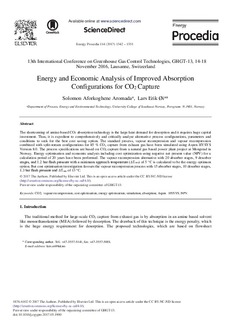| dc.contributor.author | Aromada, Solomon Aforkoghene | |
| dc.contributor.author | Øi, Lars Erik | |
| dc.date.accessioned | 2018-01-24T11:10:15Z | |
| dc.date.available | 2018-01-24T11:10:15Z | |
| dc.date.created | 2018-01-01T15:43:09Z | |
| dc.date.issued | 2017 | |
| dc.identifier.citation | Energy Procedia. 2017, 114 1342-1351. | nb_NO |
| dc.identifier.issn | 1876-6102 | |
| dc.identifier.uri | http://hdl.handle.net/11250/2479354 | |
| dc.description.abstract | The shortcoming of amine-based CO2 absorption technology is the large heat demand for desorption and it requires huge capital investment. Thus, it is expedient to comprehensively and critically analyse alternative process configurations, parameters and conditions to seek for the best cost saving option. The standard process, vapour recompression and vapour recompression combined with split-stream configurations for 85% CO2 capture from exhaust gas have been simulated using Aspen HYSYS Version 8.0. The process specifications are based on CO2 capture from a natural gas based power plant project at Mongstad in Norway. Energy optimisation and economic analysis including cost optimization using negative net present value (NPV) for a calculation period of 20 years have been performed. The vapour recompression alternative with 20 absorber stages, 9 desorber stages, and 1.2 bar flash pressure with a minimum approach temperature (ΔTmin) of 5 °C is calculated to be the energy optimum option. But cost optimisation investigation favours the vapour recompression process with 15 absorber stages, 10 desorber stages, 1.3 bar flash pressure and ΔTmin of 13 °C. | nb_NO |
| dc.language.iso | eng | nb_NO |
| dc.rights | Attribution-NonCommercial-NoDerivatives 4.0 Internasjonal | * |
| dc.rights.uri | http://creativecommons.org/licenses/by-nc-nd/4.0/deed.no | * |
| dc.subject | CO2 | nb_NO |
| dc.subject | vapour recompression | nb_NO |
| dc.subject | cost optimization | nb_NO |
| dc.subject | energy optimization | nb_NO |
| dc.subject | simulation | nb_NO |
| dc.subject | absorption | nb_NO |
| dc.subject | Aspen HYSYS | nb_NO |
| dc.subject | NPV | nb_NO |
| dc.title | Energy and Economic Analysis of Improved Absorption Configurations for CO2 Capture | nb_NO |
| dc.type | Journal article | nb_NO |
| dc.type | Peer reviewed | nb_NO |
| dc.description.version | publishedVersion | nb_NO |
| dc.source.pagenumber | 1342-1351 | nb_NO |
| dc.source.volume | 114 | nb_NO |
| dc.source.journal | Energy Procedia | nb_NO |
| dc.identifier.doi | 10.1016/j.egypro.2017.03.1900 | |
| dc.identifier.cristin | 1533280 | |
| cristin.unitcode | 222,58,3,0 | |
| cristin.unitname | Institutt for prosess-, energi- og miljøteknologi | |
| cristin.ispublished | true | |
| cristin.fulltext | original | |
| cristin.qualitycode | 1 | |

